Management and Operations: Analysis of M&S Business Practices
VerifiedAdded on 2020/07/22
|13
|3984
|77
Report
AI Summary
This report provides a comprehensive analysis of leadership and management within the context of Marks & Spencer (M&S) operations. It begins by comparing the characteristics and roles of managers and leaders, highlighting their distinct orientations, focuses, responsibilities, and approaches to risk. The report then examines the application of leadership roles and managerial functions in various situations, such as decision-making, risk-taking, and problem-solving. It further explores various theories and methods relevant to operations management, including situational leadership, system leadership, and the contingency model. The report delves into the process of management approaches, including planning, training and development, behavioral analysis, and objective setting. It also emphasizes the importance of operational management and provides an analysis of the internal and external factors affecting M&S's business. The role of a leader in the organization is discussed, including the leader's role as a representative, goal centralizer, supporting staff, administrative operator and motivator. The report concludes with a review of the leadership and management strategies employed by M&S.
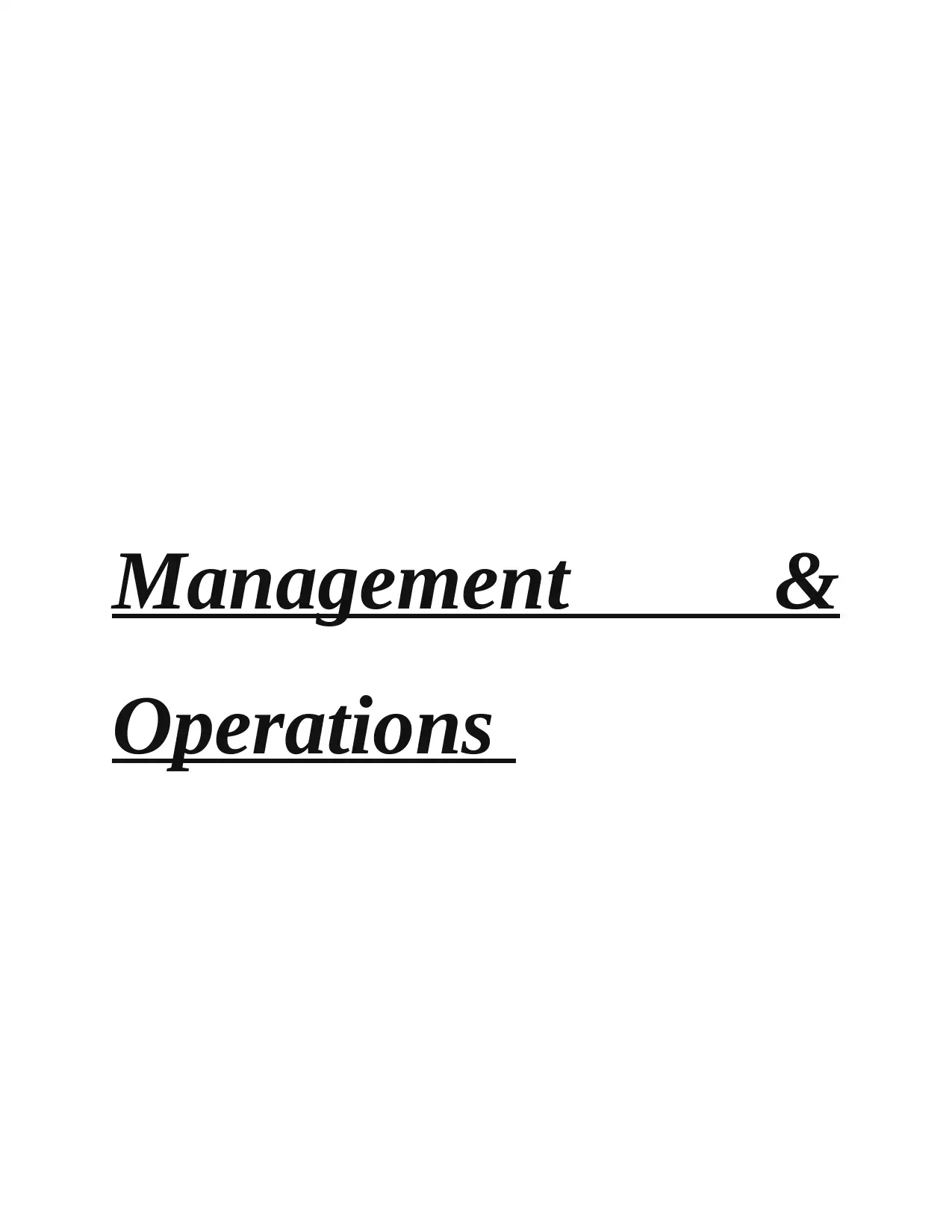
Management &
Operations
Operations
Paraphrase This Document
Need a fresh take? Get an instant paraphrase of this document with our AI Paraphraser
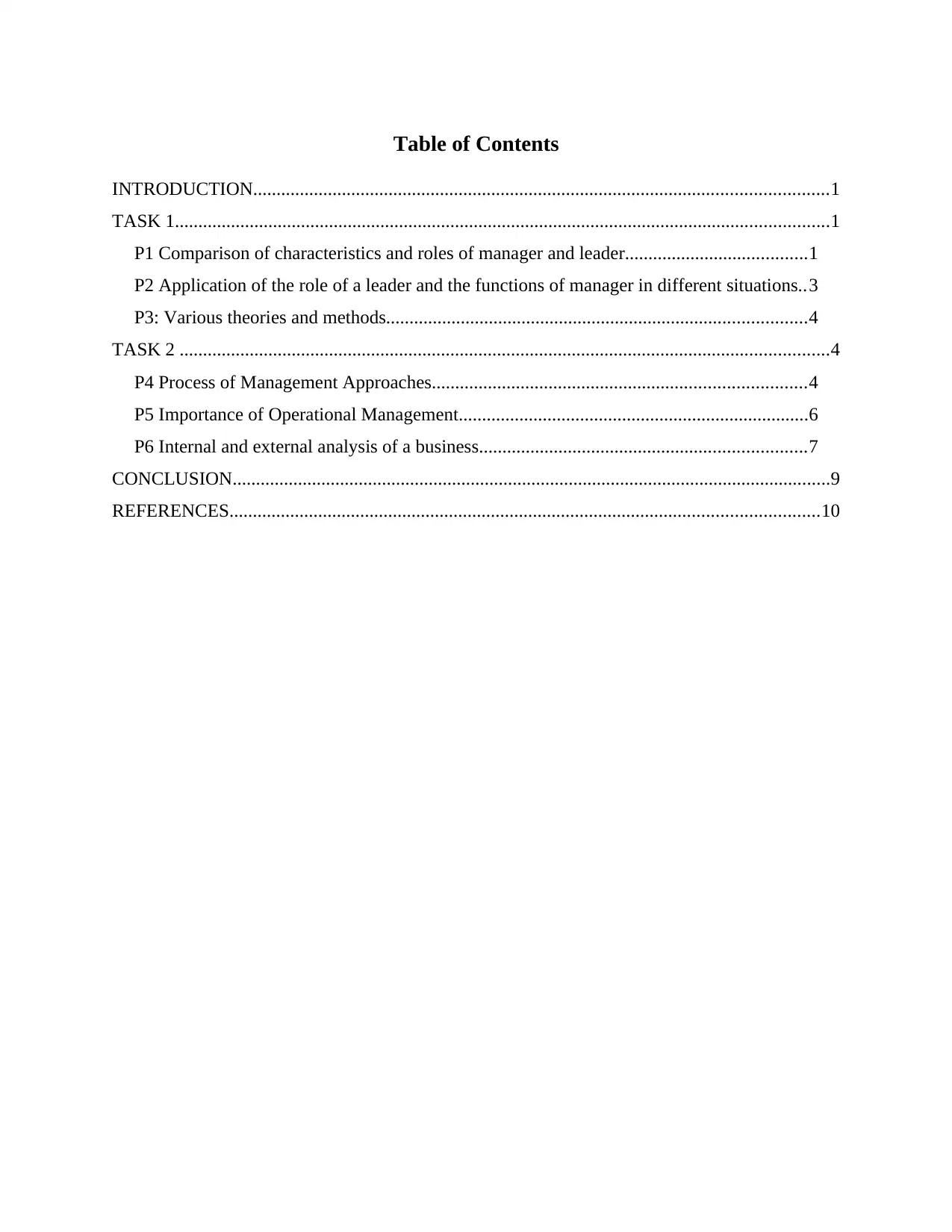
Table of Contents
INTRODUCTION...........................................................................................................................1
TASK 1............................................................................................................................................1
P1 Comparison of characteristics and roles of manager and leader.......................................1
P2 Application of the role of a leader and the functions of manager in different situations..3
P3: Various theories and methods..........................................................................................4
TASK 2 ...........................................................................................................................................4
P4 Process of Management Approaches................................................................................4
P5 Importance of Operational Management...........................................................................6
P6 Internal and external analysis of a business......................................................................7
CONCLUSION................................................................................................................................9
REFERENCES..............................................................................................................................10
INTRODUCTION...........................................................................................................................1
TASK 1............................................................................................................................................1
P1 Comparison of characteristics and roles of manager and leader.......................................1
P2 Application of the role of a leader and the functions of manager in different situations..3
P3: Various theories and methods..........................................................................................4
TASK 2 ...........................................................................................................................................4
P4 Process of Management Approaches................................................................................4
P5 Importance of Operational Management...........................................................................6
P6 Internal and external analysis of a business......................................................................7
CONCLUSION................................................................................................................................9
REFERENCES..............................................................................................................................10
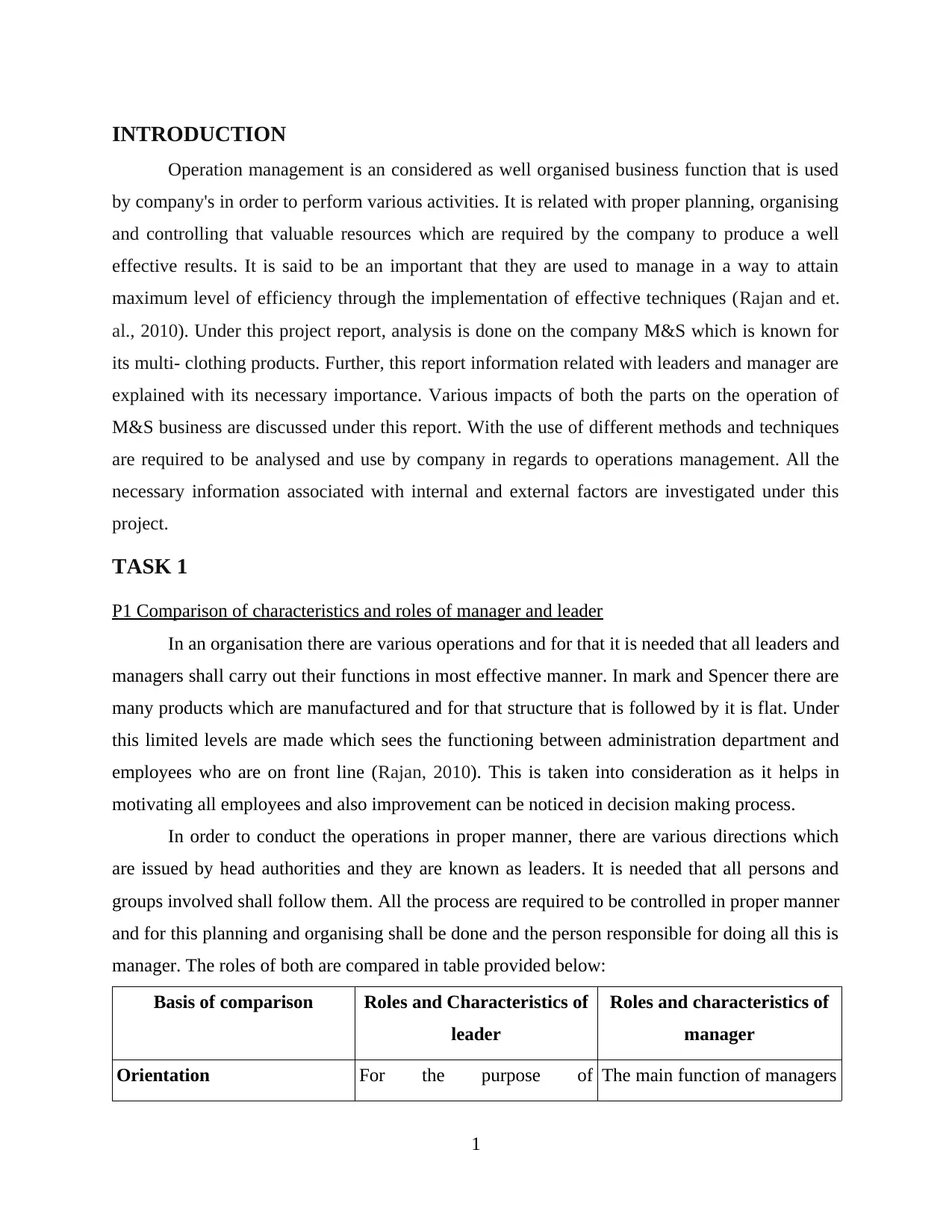
INTRODUCTION
Operation management is an considered as well organised business function that is used
by company's in order to perform various activities. It is related with proper planning, organising
and controlling that valuable resources which are required by the company to produce a well
effective results. It is said to be an important that they are used to manage in a way to attain
maximum level of efficiency through the implementation of effective techniques (Rajan and et.
al., 2010). Under this project report, analysis is done on the company M&S which is known for
its multi- clothing products. Further, this report information related with leaders and manager are
explained with its necessary importance. Various impacts of both the parts on the operation of
M&S business are discussed under this report. With the use of different methods and techniques
are required to be analysed and use by company in regards to operations management. All the
necessary information associated with internal and external factors are investigated under this
project.
TASK 1
P1 Comparison of characteristics and roles of manager and leader
In an organisation there are various operations and for that it is needed that all leaders and
managers shall carry out their functions in most effective manner. In mark and Spencer there are
many products which are manufactured and for that structure that is followed by it is flat. Under
this limited levels are made which sees the functioning between administration department and
employees who are on front line (Rajan, 2010). This is taken into consideration as it helps in
motivating all employees and also improvement can be noticed in decision making process.
In order to conduct the operations in proper manner, there are various directions which
are issued by head authorities and they are known as leaders. It is needed that all persons and
groups involved shall follow them. All the process are required to be controlled in proper manner
and for this planning and organising shall be done and the person responsible for doing all this is
manager. The roles of both are compared in table provided below:
Basis of comparison Roles and Characteristics of
leader
Roles and characteristics of
manager
Orientation For the purpose of The main function of managers
1
Operation management is an considered as well organised business function that is used
by company's in order to perform various activities. It is related with proper planning, organising
and controlling that valuable resources which are required by the company to produce a well
effective results. It is said to be an important that they are used to manage in a way to attain
maximum level of efficiency through the implementation of effective techniques (Rajan and et.
al., 2010). Under this project report, analysis is done on the company M&S which is known for
its multi- clothing products. Further, this report information related with leaders and manager are
explained with its necessary importance. Various impacts of both the parts on the operation of
M&S business are discussed under this report. With the use of different methods and techniques
are required to be analysed and use by company in regards to operations management. All the
necessary information associated with internal and external factors are investigated under this
project.
TASK 1
P1 Comparison of characteristics and roles of manager and leader
In an organisation there are various operations and for that it is needed that all leaders and
managers shall carry out their functions in most effective manner. In mark and Spencer there are
many products which are manufactured and for that structure that is followed by it is flat. Under
this limited levels are made which sees the functioning between administration department and
employees who are on front line (Rajan, 2010). This is taken into consideration as it helps in
motivating all employees and also improvement can be noticed in decision making process.
In order to conduct the operations in proper manner, there are various directions which
are issued by head authorities and they are known as leaders. It is needed that all persons and
groups involved shall follow them. All the process are required to be controlled in proper manner
and for this planning and organising shall be done and the person responsible for doing all this is
manager. The roles of both are compared in table provided below:
Basis of comparison Roles and Characteristics of
leader
Roles and characteristics of
manager
Orientation For the purpose of The main function of managers
1
⊘ This is a preview!⊘
Do you want full access?
Subscribe today to unlock all pages.

Trusted by 1+ million students worldwide
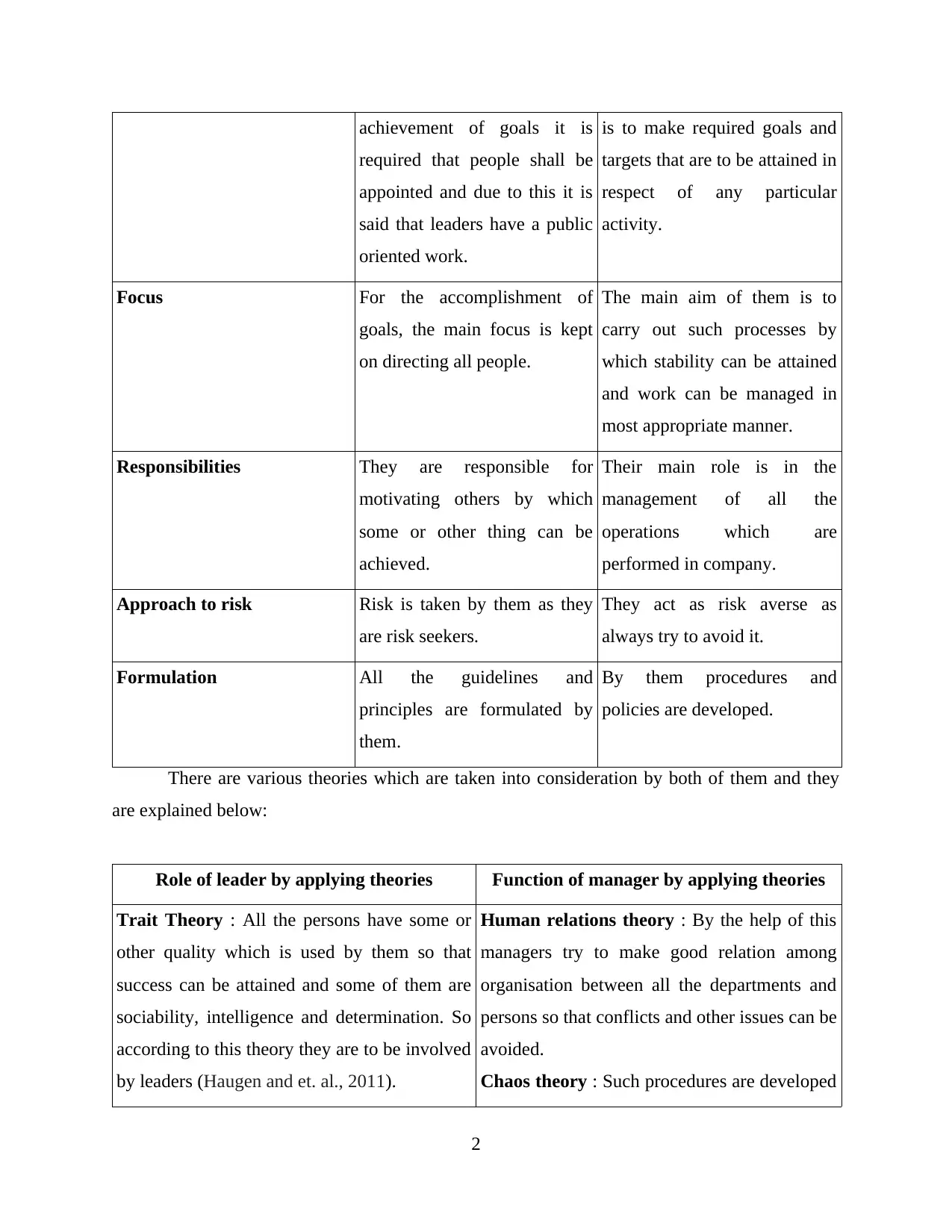
achievement of goals it is
required that people shall be
appointed and due to this it is
said that leaders have a public
oriented work.
is to make required goals and
targets that are to be attained in
respect of any particular
activity.
Focus For the accomplishment of
goals, the main focus is kept
on directing all people.
The main aim of them is to
carry out such processes by
which stability can be attained
and work can be managed in
most appropriate manner.
Responsibilities They are responsible for
motivating others by which
some or other thing can be
achieved.
Their main role is in the
management of all the
operations which are
performed in company.
Approach to risk Risk is taken by them as they
are risk seekers.
They act as risk averse as
always try to avoid it.
Formulation All the guidelines and
principles are formulated by
them.
By them procedures and
policies are developed.
There are various theories which are taken into consideration by both of them and they
are explained below:
Role of leader by applying theories Function of manager by applying theories
Trait Theory : All the persons have some or
other quality which is used by them so that
success can be attained and some of them are
sociability, intelligence and determination. So
according to this theory they are to be involved
by leaders (Haugen and et. al., 2011).
Human relations theory : By the help of this
managers try to make good relation among
organisation between all the departments and
persons so that conflicts and other issues can be
avoided.
Chaos theory : Such procedures are developed
2
required that people shall be
appointed and due to this it is
said that leaders have a public
oriented work.
is to make required goals and
targets that are to be attained in
respect of any particular
activity.
Focus For the accomplishment of
goals, the main focus is kept
on directing all people.
The main aim of them is to
carry out such processes by
which stability can be attained
and work can be managed in
most appropriate manner.
Responsibilities They are responsible for
motivating others by which
some or other thing can be
achieved.
Their main role is in the
management of all the
operations which are
performed in company.
Approach to risk Risk is taken by them as they
are risk seekers.
They act as risk averse as
always try to avoid it.
Formulation All the guidelines and
principles are formulated by
them.
By them procedures and
policies are developed.
There are various theories which are taken into consideration by both of them and they
are explained below:
Role of leader by applying theories Function of manager by applying theories
Trait Theory : All the persons have some or
other quality which is used by them so that
success can be attained and some of them are
sociability, intelligence and determination. So
according to this theory they are to be involved
by leaders (Haugen and et. al., 2011).
Human relations theory : By the help of this
managers try to make good relation among
organisation between all the departments and
persons so that conflicts and other issues can be
avoided.
Chaos theory : Such procedures are developed
2
Paraphrase This Document
Need a fresh take? Get an instant paraphrase of this document with our AI Paraphraser
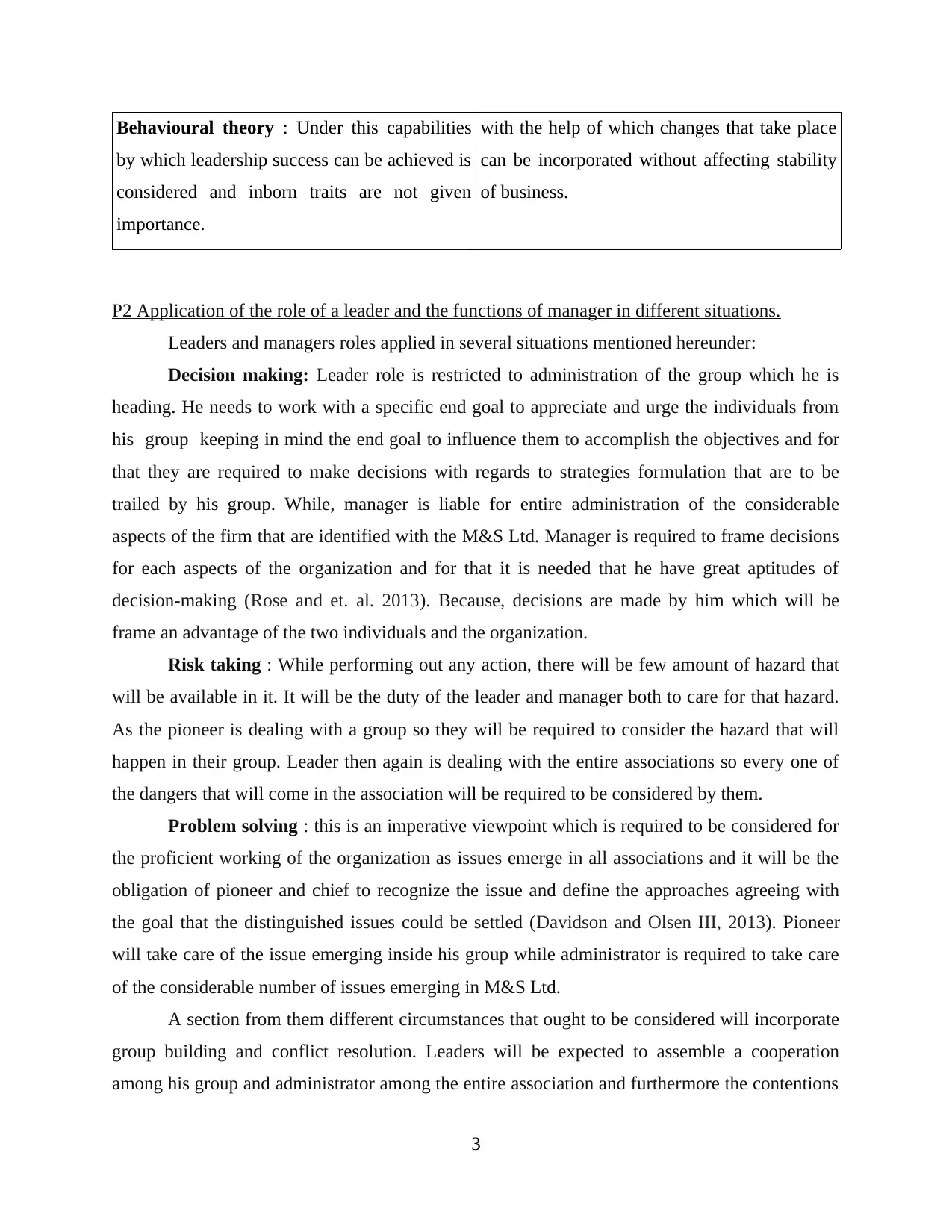
Behavioural theory : Under this capabilities
by which leadership success can be achieved is
considered and inborn traits are not given
importance.
with the help of which changes that take place
can be incorporated without affecting stability
of business.
P2 Application of the role of a leader and the functions of manager in different situations.
Leaders and managers roles applied in several situations mentioned hereunder:
Decision making: Leader role is restricted to administration of the group which he is
heading. He needs to work with a specific end goal to appreciate and urge the individuals from
his group keeping in mind the end goal to influence them to accomplish the objectives and for
that they are required to make decisions with regards to strategies formulation that are to be
trailed by his group. While, manager is liable for entire administration of the considerable
aspects of the firm that are identified with the M&S Ltd. Manager is required to frame decisions
for each aspects of the organization and for that it is needed that he have great aptitudes of
decision-making (Rose and et. al. 2013). Because, decisions are made by him which will be
frame an advantage of the two individuals and the organization.
Risk taking : While performing out any action, there will be few amount of hazard that
will be available in it. It will be the duty of the leader and manager both to care for that hazard.
As the pioneer is dealing with a group so they will be required to consider the hazard that will
happen in their group. Leader then again is dealing with the entire associations so every one of
the dangers that will come in the association will be required to be considered by them.
Problem solving : this is an imperative viewpoint which is required to be considered for
the proficient working of the organization as issues emerge in all associations and it will be the
obligation of pioneer and chief to recognize the issue and define the approaches agreeing with
the goal that the distinguished issues could be settled (Davidson and Olsen III, 2013). Pioneer
will take care of the issue emerging inside his group while administrator is required to take care
of the considerable number of issues emerging in M&S Ltd.
A section from them different circumstances that ought to be considered will incorporate
group building and conflict resolution. Leaders will be expected to assemble a cooperation
among his group and administrator among the entire association and furthermore the contentions
3
by which leadership success can be achieved is
considered and inborn traits are not given
importance.
with the help of which changes that take place
can be incorporated without affecting stability
of business.
P2 Application of the role of a leader and the functions of manager in different situations.
Leaders and managers roles applied in several situations mentioned hereunder:
Decision making: Leader role is restricted to administration of the group which he is
heading. He needs to work with a specific end goal to appreciate and urge the individuals from
his group keeping in mind the end goal to influence them to accomplish the objectives and for
that they are required to make decisions with regards to strategies formulation that are to be
trailed by his group. While, manager is liable for entire administration of the considerable
aspects of the firm that are identified with the M&S Ltd. Manager is required to frame decisions
for each aspects of the organization and for that it is needed that he have great aptitudes of
decision-making (Rose and et. al. 2013). Because, decisions are made by him which will be
frame an advantage of the two individuals and the organization.
Risk taking : While performing out any action, there will be few amount of hazard that
will be available in it. It will be the duty of the leader and manager both to care for that hazard.
As the pioneer is dealing with a group so they will be required to consider the hazard that will
happen in their group. Leader then again is dealing with the entire associations so every one of
the dangers that will come in the association will be required to be considered by them.
Problem solving : this is an imperative viewpoint which is required to be considered for
the proficient working of the organization as issues emerge in all associations and it will be the
obligation of pioneer and chief to recognize the issue and define the approaches agreeing with
the goal that the distinguished issues could be settled (Davidson and Olsen III, 2013). Pioneer
will take care of the issue emerging inside his group while administrator is required to take care
of the considerable number of issues emerging in M&S Ltd.
A section from them different circumstances that ought to be considered will incorporate
group building and conflict resolution. Leaders will be expected to assemble a cooperation
among his group and administrator among the entire association and furthermore the contentions
3
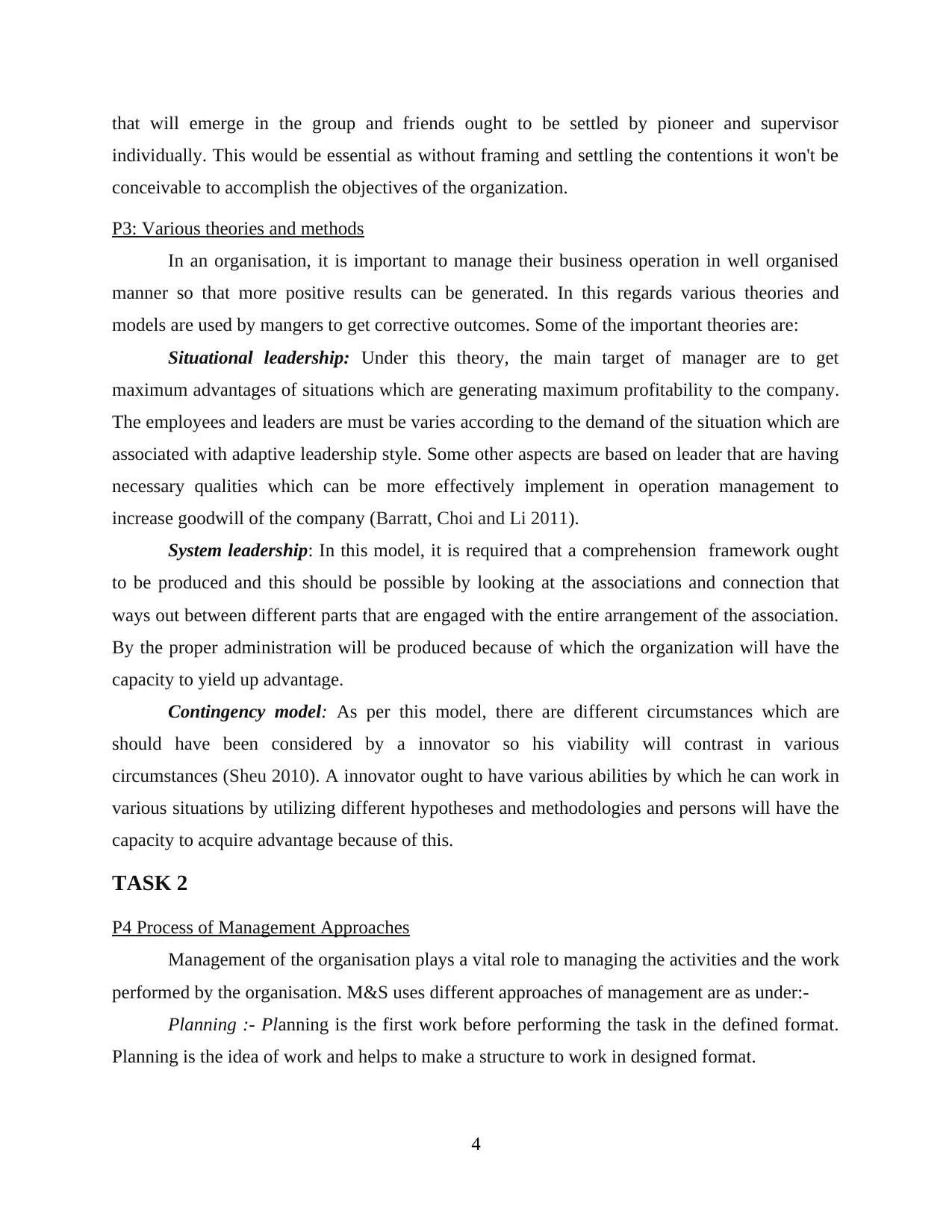
that will emerge in the group and friends ought to be settled by pioneer and supervisor
individually. This would be essential as without framing and settling the contentions it won't be
conceivable to accomplish the objectives of the organization.
P3: Various theories and methods
In an organisation, it is important to manage their business operation in well organised
manner so that more positive results can be generated. In this regards various theories and
models are used by mangers to get corrective outcomes. Some of the important theories are:
Situational leadership: Under this theory, the main target of manager are to get
maximum advantages of situations which are generating maximum profitability to the company.
The employees and leaders are must be varies according to the demand of the situation which are
associated with adaptive leadership style. Some other aspects are based on leader that are having
necessary qualities which can be more effectively implement in operation management to
increase goodwill of the company (Barratt, Choi and Li 2011).
System leadership: In this model, it is required that a comprehension framework ought
to be produced and this should be possible by looking at the associations and connection that
ways out between different parts that are engaged with the entire arrangement of the association.
By the proper administration will be produced because of which the organization will have the
capacity to yield up advantage.
Contingency model: As per this model, there are different circumstances which are
should have been considered by a innovator so his viability will contrast in various
circumstances (Sheu 2010). A innovator ought to have various abilities by which he can work in
various situations by utilizing different hypotheses and methodologies and persons will have the
capacity to acquire advantage because of this.
TASK 2
P4 Process of Management Approaches
Management of the organisation plays a vital role to managing the activities and the work
performed by the organisation. M&S uses different approaches of management are as under:-
Planning :- Planning is the first work before performing the task in the defined format.
Planning is the idea of work and helps to make a structure to work in designed format.
4
individually. This would be essential as without framing and settling the contentions it won't be
conceivable to accomplish the objectives of the organization.
P3: Various theories and methods
In an organisation, it is important to manage their business operation in well organised
manner so that more positive results can be generated. In this regards various theories and
models are used by mangers to get corrective outcomes. Some of the important theories are:
Situational leadership: Under this theory, the main target of manager are to get
maximum advantages of situations which are generating maximum profitability to the company.
The employees and leaders are must be varies according to the demand of the situation which are
associated with adaptive leadership style. Some other aspects are based on leader that are having
necessary qualities which can be more effectively implement in operation management to
increase goodwill of the company (Barratt, Choi and Li 2011).
System leadership: In this model, it is required that a comprehension framework ought
to be produced and this should be possible by looking at the associations and connection that
ways out between different parts that are engaged with the entire arrangement of the association.
By the proper administration will be produced because of which the organization will have the
capacity to yield up advantage.
Contingency model: As per this model, there are different circumstances which are
should have been considered by a innovator so his viability will contrast in various
circumstances (Sheu 2010). A innovator ought to have various abilities by which he can work in
various situations by utilizing different hypotheses and methodologies and persons will have the
capacity to acquire advantage because of this.
TASK 2
P4 Process of Management Approaches
Management of the organisation plays a vital role to managing the activities and the work
performed by the organisation. M&S uses different approaches of management are as under:-
Planning :- Planning is the first work before performing the task in the defined format.
Planning is the idea of work and helps to make a structure to work in designed format.
4
⊘ This is a preview!⊘
Do you want full access?
Subscribe today to unlock all pages.

Trusted by 1+ million students worldwide
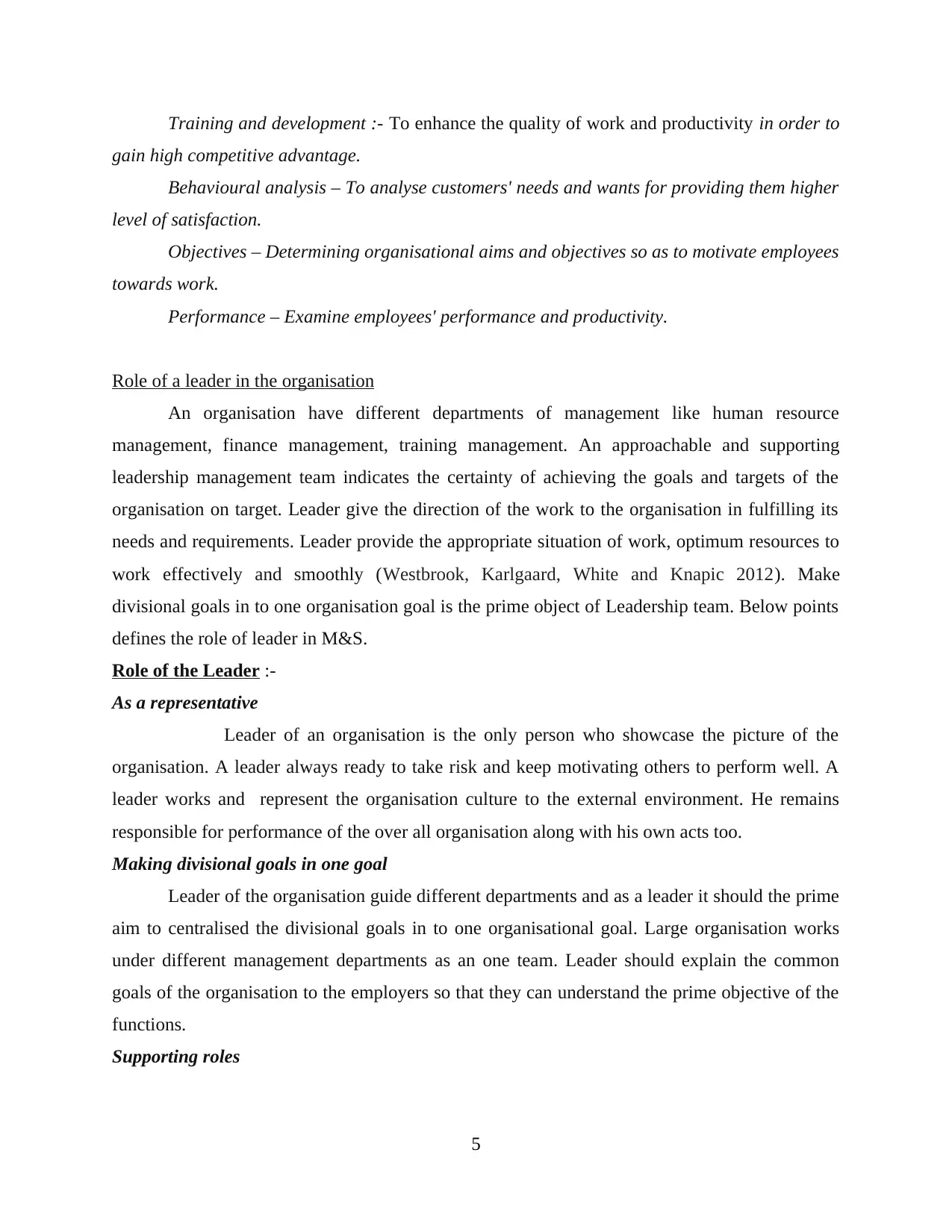
Training and development :- To enhance the quality of work and productivity in order to
gain high competitive advantage.
Behavioural analysis – To analyse customers' needs and wants for providing them higher
level of satisfaction.
Objectives – Determining organisational aims and objectives so as to motivate employees
towards work.
Performance – Examine employees' performance and productivity.
Role of a leader in the organisation
An organisation have different departments of management like human resource
management, finance management, training management. An approachable and supporting
leadership management team indicates the certainty of achieving the goals and targets of the
organisation on target. Leader give the direction of the work to the organisation in fulfilling its
needs and requirements. Leader provide the appropriate situation of work, optimum resources to
work effectively and smoothly (Westbrook, Karlgaard, White and Knapic 2012). Make
divisional goals in to one organisation goal is the prime object of Leadership team. Below points
defines the role of leader in M&S.
Role of the Leader :-
As a representative
Leader of an organisation is the only person who showcase the picture of the
organisation. A leader always ready to take risk and keep motivating others to perform well. A
leader works and represent the organisation culture to the external environment. He remains
responsible for performance of the over all organisation along with his own acts too.
Making divisional goals in one goal
Leader of the organisation guide different departments and as a leader it should the prime
aim to centralised the divisional goals in to one organisational goal. Large organisation works
under different management departments as an one team. Leader should explain the common
goals of the organisation to the employers so that they can understand the prime objective of the
functions.
Supporting roles
5
gain high competitive advantage.
Behavioural analysis – To analyse customers' needs and wants for providing them higher
level of satisfaction.
Objectives – Determining organisational aims and objectives so as to motivate employees
towards work.
Performance – Examine employees' performance and productivity.
Role of a leader in the organisation
An organisation have different departments of management like human resource
management, finance management, training management. An approachable and supporting
leadership management team indicates the certainty of achieving the goals and targets of the
organisation on target. Leader give the direction of the work to the organisation in fulfilling its
needs and requirements. Leader provide the appropriate situation of work, optimum resources to
work effectively and smoothly (Westbrook, Karlgaard, White and Knapic 2012). Make
divisional goals in to one organisation goal is the prime object of Leadership team. Below points
defines the role of leader in M&S.
Role of the Leader :-
As a representative
Leader of an organisation is the only person who showcase the picture of the
organisation. A leader always ready to take risk and keep motivating others to perform well. A
leader works and represent the organisation culture to the external environment. He remains
responsible for performance of the over all organisation along with his own acts too.
Making divisional goals in one goal
Leader of the organisation guide different departments and as a leader it should the prime
aim to centralised the divisional goals in to one organisational goal. Large organisation works
under different management departments as an one team. Leader should explain the common
goals of the organisation to the employers so that they can understand the prime objective of the
functions.
Supporting roles
5
Paraphrase This Document
Need a fresh take? Get an instant paraphrase of this document with our AI Paraphraser
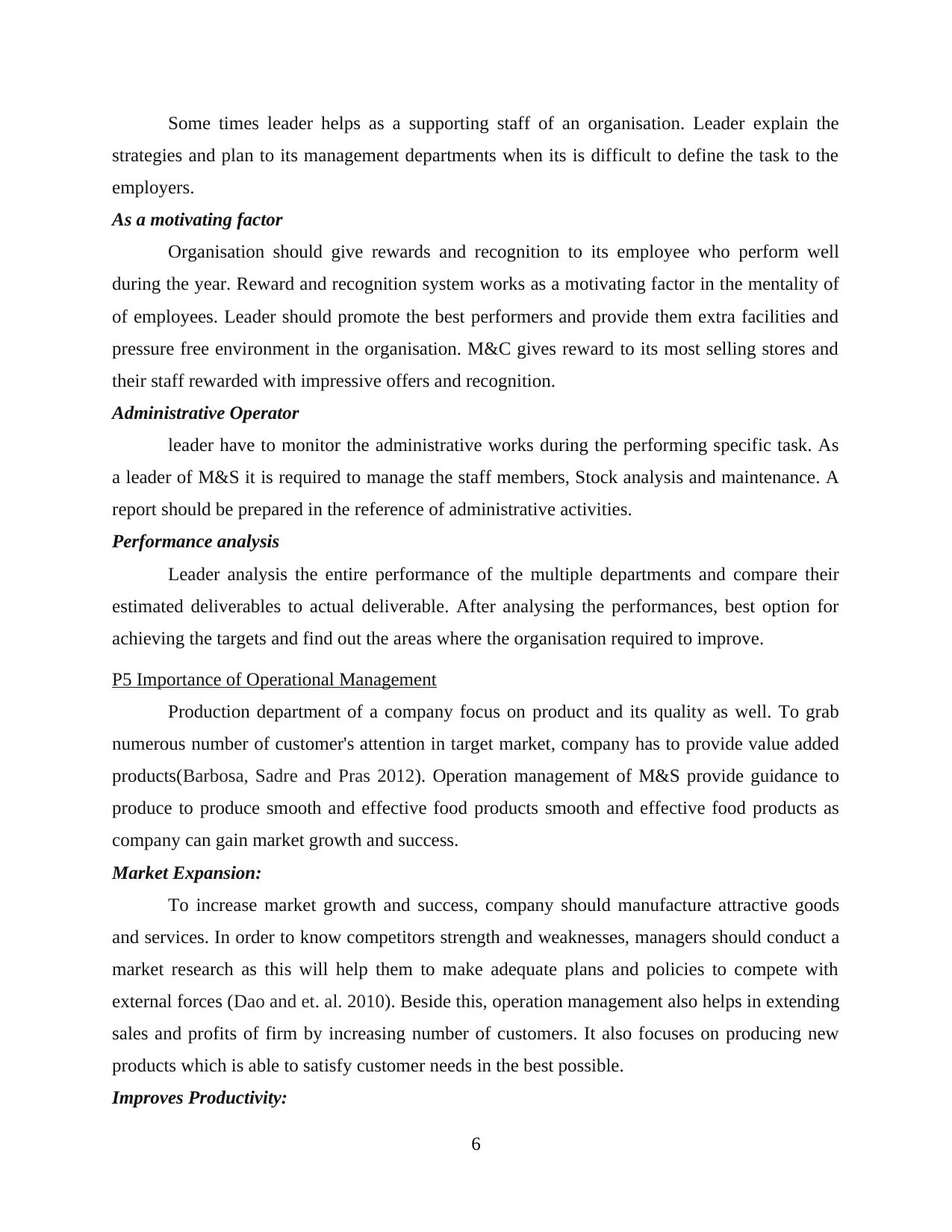
Some times leader helps as a supporting staff of an organisation. Leader explain the
strategies and plan to its management departments when its is difficult to define the task to the
employers.
As a motivating factor
Organisation should give rewards and recognition to its employee who perform well
during the year. Reward and recognition system works as a motivating factor in the mentality of
of employees. Leader should promote the best performers and provide them extra facilities and
pressure free environment in the organisation. M&C gives reward to its most selling stores and
their staff rewarded with impressive offers and recognition.
Administrative Operator
leader have to monitor the administrative works during the performing specific task. As
a leader of M&S it is required to manage the staff members, Stock analysis and maintenance. A
report should be prepared in the reference of administrative activities.
Performance analysis
Leader analysis the entire performance of the multiple departments and compare their
estimated deliverables to actual deliverable. After analysing the performances, best option for
achieving the targets and find out the areas where the organisation required to improve.
P5 Importance of Operational Management
Production department of a company focus on product and its quality as well. To grab
numerous number of customer's attention in target market, company has to provide value added
products(Barbosa, Sadre and Pras 2012). Operation management of M&S provide guidance to
produce to produce smooth and effective food products smooth and effective food products as
company can gain market growth and success.
Market Expansion:
To increase market growth and success, company should manufacture attractive goods
and services. In order to know competitors strength and weaknesses, managers should conduct a
market research as this will help them to make adequate plans and policies to compete with
external forces (Dao and et. al. 2010). Beside this, operation management also helps in extending
sales and profits of firm by increasing number of customers. It also focuses on producing new
products which is able to satisfy customer needs in the best possible.
Improves Productivity:
6
strategies and plan to its management departments when its is difficult to define the task to the
employers.
As a motivating factor
Organisation should give rewards and recognition to its employee who perform well
during the year. Reward and recognition system works as a motivating factor in the mentality of
of employees. Leader should promote the best performers and provide them extra facilities and
pressure free environment in the organisation. M&C gives reward to its most selling stores and
their staff rewarded with impressive offers and recognition.
Administrative Operator
leader have to monitor the administrative works during the performing specific task. As
a leader of M&S it is required to manage the staff members, Stock analysis and maintenance. A
report should be prepared in the reference of administrative activities.
Performance analysis
Leader analysis the entire performance of the multiple departments and compare their
estimated deliverables to actual deliverable. After analysing the performances, best option for
achieving the targets and find out the areas where the organisation required to improve.
P5 Importance of Operational Management
Production department of a company focus on product and its quality as well. To grab
numerous number of customer's attention in target market, company has to provide value added
products(Barbosa, Sadre and Pras 2012). Operation management of M&S provide guidance to
produce to produce smooth and effective food products smooth and effective food products as
company can gain market growth and success.
Market Expansion:
To increase market growth and success, company should manufacture attractive goods
and services. In order to know competitors strength and weaknesses, managers should conduct a
market research as this will help them to make adequate plans and policies to compete with
external forces (Dao and et. al. 2010). Beside this, operation management also helps in extending
sales and profits of firm by increasing number of customers. It also focuses on producing new
products which is able to satisfy customer needs in the best possible.
Improves Productivity:
6
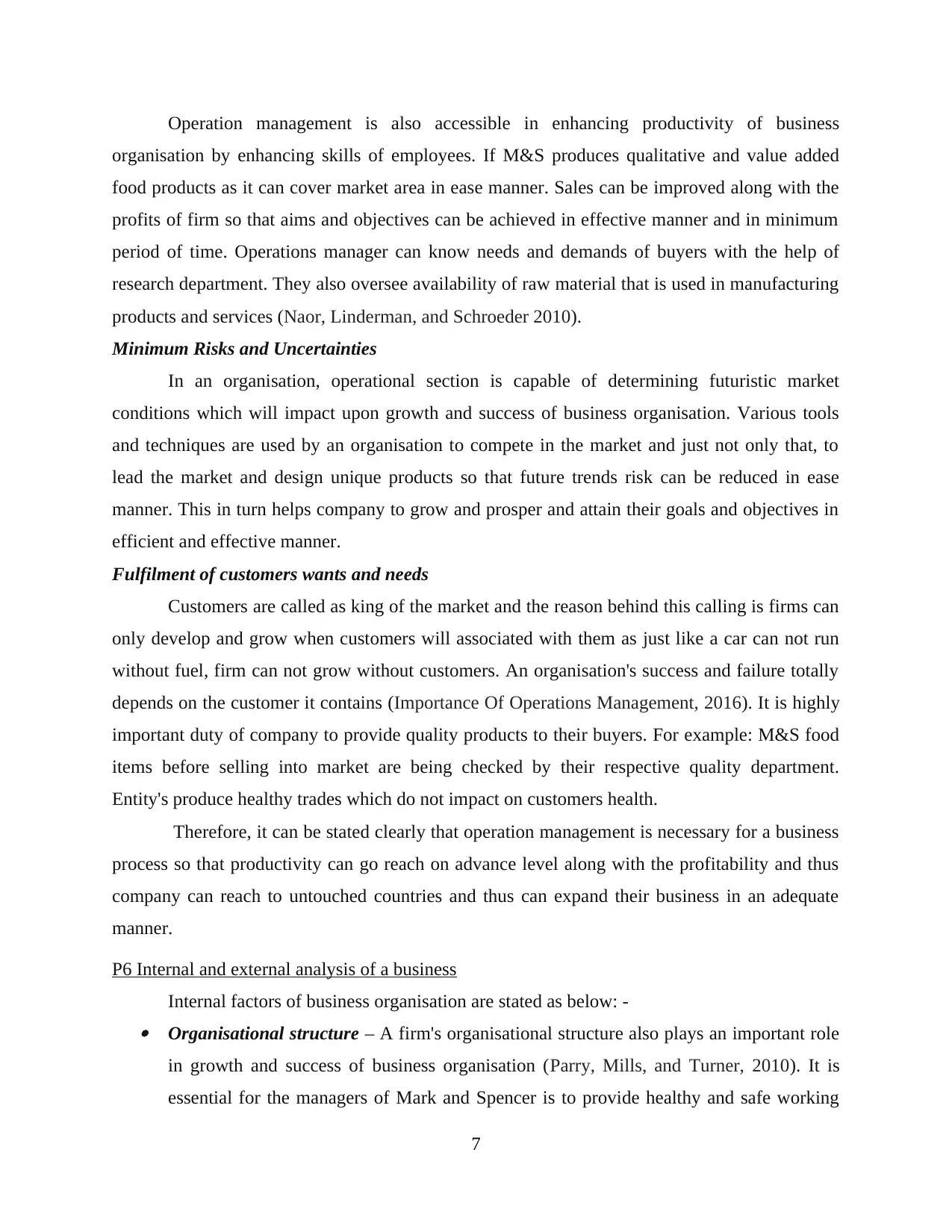
Operation management is also accessible in enhancing productivity of business
organisation by enhancing skills of employees. If M&S produces qualitative and value added
food products as it can cover market area in ease manner. Sales can be improved along with the
profits of firm so that aims and objectives can be achieved in effective manner and in minimum
period of time. Operations manager can know needs and demands of buyers with the help of
research department. They also oversee availability of raw material that is used in manufacturing
products and services (Naor, Linderman, and Schroeder 2010).
Minimum Risks and Uncertainties
In an organisation, operational section is capable of determining futuristic market
conditions which will impact upon growth and success of business organisation. Various tools
and techniques are used by an organisation to compete in the market and just not only that, to
lead the market and design unique products so that future trends risk can be reduced in ease
manner. This in turn helps company to grow and prosper and attain their goals and objectives in
efficient and effective manner.
Fulfilment of customers wants and needs
Customers are called as king of the market and the reason behind this calling is firms can
only develop and grow when customers will associated with them as just like a car can not run
without fuel, firm can not grow without customers. An organisation's success and failure totally
depends on the customer it contains (Importance Of Operations Management, 2016). It is highly
important duty of company to provide quality products to their buyers. For example: M&S food
items before selling into market are being checked by their respective quality department.
Entity's produce healthy trades which do not impact on customers health.
Therefore, it can be stated clearly that operation management is necessary for a business
process so that productivity can go reach on advance level along with the profitability and thus
company can reach to untouched countries and thus can expand their business in an adequate
manner.
P6 Internal and external analysis of a business
Internal factors of business organisation are stated as below: - Organisational structure – A firm's organisational structure also plays an important role
in growth and success of business organisation (Parry, Mills, and Turner, 2010). It is
essential for the managers of Mark and Spencer is to provide healthy and safe working
7
organisation by enhancing skills of employees. If M&S produces qualitative and value added
food products as it can cover market area in ease manner. Sales can be improved along with the
profits of firm so that aims and objectives can be achieved in effective manner and in minimum
period of time. Operations manager can know needs and demands of buyers with the help of
research department. They also oversee availability of raw material that is used in manufacturing
products and services (Naor, Linderman, and Schroeder 2010).
Minimum Risks and Uncertainties
In an organisation, operational section is capable of determining futuristic market
conditions which will impact upon growth and success of business organisation. Various tools
and techniques are used by an organisation to compete in the market and just not only that, to
lead the market and design unique products so that future trends risk can be reduced in ease
manner. This in turn helps company to grow and prosper and attain their goals and objectives in
efficient and effective manner.
Fulfilment of customers wants and needs
Customers are called as king of the market and the reason behind this calling is firms can
only develop and grow when customers will associated with them as just like a car can not run
without fuel, firm can not grow without customers. An organisation's success and failure totally
depends on the customer it contains (Importance Of Operations Management, 2016). It is highly
important duty of company to provide quality products to their buyers. For example: M&S food
items before selling into market are being checked by their respective quality department.
Entity's produce healthy trades which do not impact on customers health.
Therefore, it can be stated clearly that operation management is necessary for a business
process so that productivity can go reach on advance level along with the profitability and thus
company can reach to untouched countries and thus can expand their business in an adequate
manner.
P6 Internal and external analysis of a business
Internal factors of business organisation are stated as below: - Organisational structure – A firm's organisational structure also plays an important role
in growth and success of business organisation (Parry, Mills, and Turner, 2010). It is
essential for the managers of Mark and Spencer is to provide healthy and safe working
7
⊘ This is a preview!⊘
Do you want full access?
Subscribe today to unlock all pages.

Trusted by 1+ million students worldwide
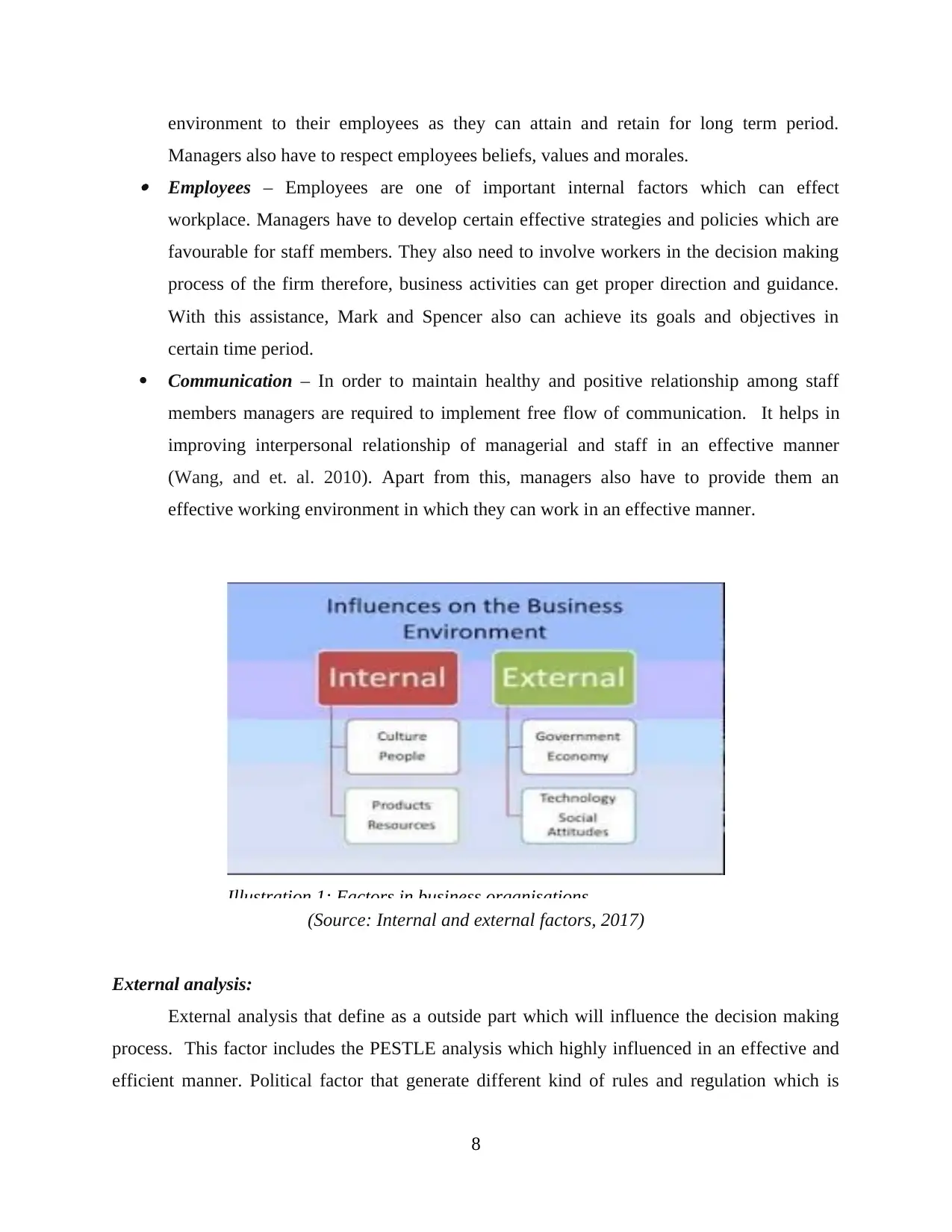
environment to their employees as they can attain and retain for long term period.
Managers also have to respect employees beliefs, values and morales. Employees – Employees are one of important internal factors which can effect
workplace. Managers have to develop certain effective strategies and policies which are
favourable for staff members. They also need to involve workers in the decision making
process of the firm therefore, business activities can get proper direction and guidance.
With this assistance, Mark and Spencer also can achieve its goals and objectives in
certain time period.
Communication – In order to maintain healthy and positive relationship among staff
members managers are required to implement free flow of communication. It helps in
improving interpersonal relationship of managerial and staff in an effective manner
(Wang, and et. al. 2010). Apart from this, managers also have to provide them an
effective working environment in which they can work in an effective manner.
(Source: Internal and external factors, 2017)
External analysis:
External analysis that define as a outside part which will influence the decision making
process. This factor includes the PESTLE analysis which highly influenced in an effective and
efficient manner. Political factor that generate different kind of rules and regulation which is
8
Illustration 1: Factors in business organisations
Managers also have to respect employees beliefs, values and morales. Employees – Employees are one of important internal factors which can effect
workplace. Managers have to develop certain effective strategies and policies which are
favourable for staff members. They also need to involve workers in the decision making
process of the firm therefore, business activities can get proper direction and guidance.
With this assistance, Mark and Spencer also can achieve its goals and objectives in
certain time period.
Communication – In order to maintain healthy and positive relationship among staff
members managers are required to implement free flow of communication. It helps in
improving interpersonal relationship of managerial and staff in an effective manner
(Wang, and et. al. 2010). Apart from this, managers also have to provide them an
effective working environment in which they can work in an effective manner.
(Source: Internal and external factors, 2017)
External analysis:
External analysis that define as a outside part which will influence the decision making
process. This factor includes the PESTLE analysis which highly influenced in an effective and
efficient manner. Political factor that generate different kind of rules and regulation which is
8
Illustration 1: Factors in business organisations
Paraphrase This Document
Need a fresh take? Get an instant paraphrase of this document with our AI Paraphraser
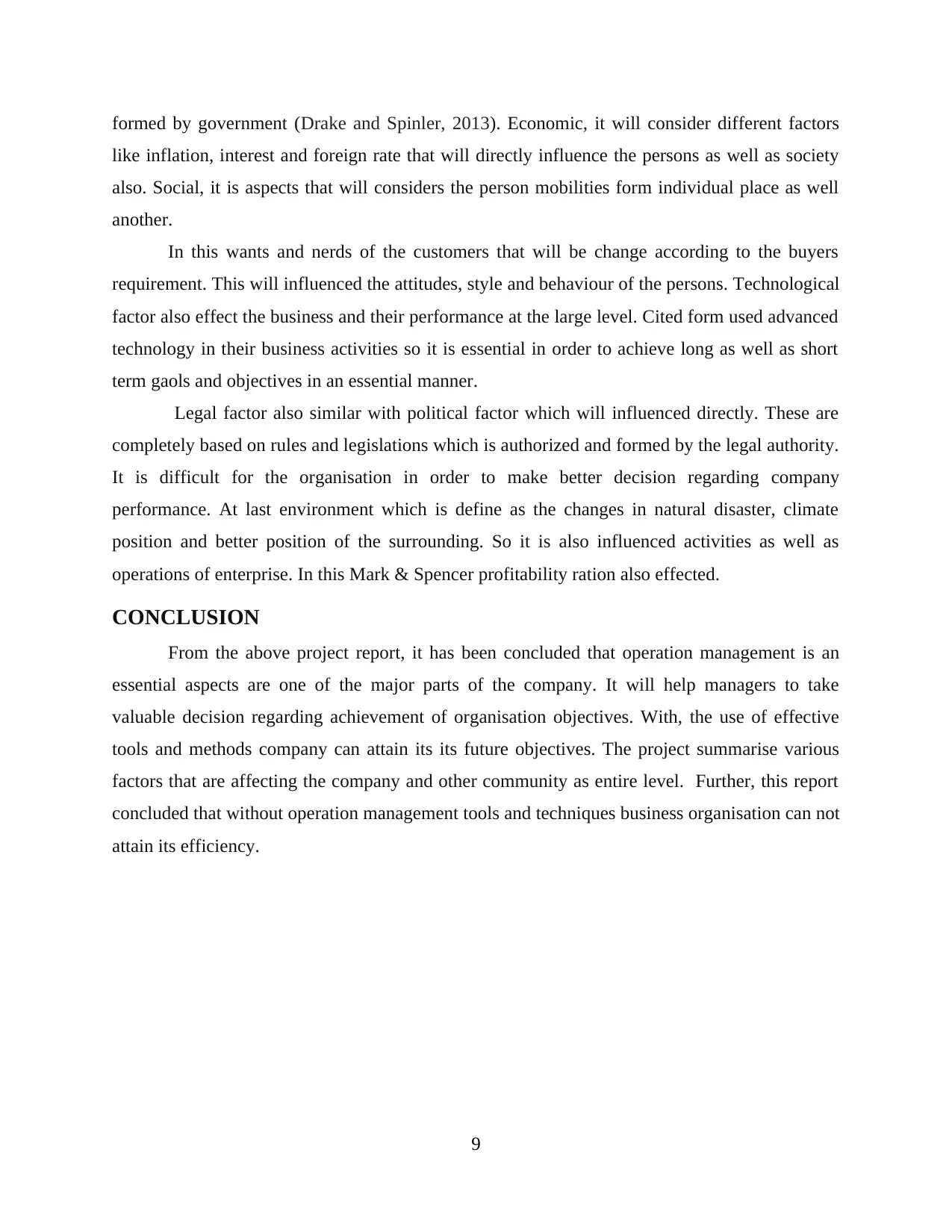
formed by government (Drake and Spinler, 2013). Economic, it will consider different factors
like inflation, interest and foreign rate that will directly influence the persons as well as society
also. Social, it is aspects that will considers the person mobilities form individual place as well
another.
In this wants and nerds of the customers that will be change according to the buyers
requirement. This will influenced the attitudes, style and behaviour of the persons. Technological
factor also effect the business and their performance at the large level. Cited form used advanced
technology in their business activities so it is essential in order to achieve long as well as short
term gaols and objectives in an essential manner.
Legal factor also similar with political factor which will influenced directly. These are
completely based on rules and legislations which is authorized and formed by the legal authority.
It is difficult for the organisation in order to make better decision regarding company
performance. At last environment which is define as the changes in natural disaster, climate
position and better position of the surrounding. So it is also influenced activities as well as
operations of enterprise. In this Mark & Spencer profitability ration also effected.
CONCLUSION
From the above project report, it has been concluded that operation management is an
essential aspects are one of the major parts of the company. It will help managers to take
valuable decision regarding achievement of organisation objectives. With, the use of effective
tools and methods company can attain its its future objectives. The project summarise various
factors that are affecting the company and other community as entire level. Further, this report
concluded that without operation management tools and techniques business organisation can not
attain its efficiency.
9
like inflation, interest and foreign rate that will directly influence the persons as well as society
also. Social, it is aspects that will considers the person mobilities form individual place as well
another.
In this wants and nerds of the customers that will be change according to the buyers
requirement. This will influenced the attitudes, style and behaviour of the persons. Technological
factor also effect the business and their performance at the large level. Cited form used advanced
technology in their business activities so it is essential in order to achieve long as well as short
term gaols and objectives in an essential manner.
Legal factor also similar with political factor which will influenced directly. These are
completely based on rules and legislations which is authorized and formed by the legal authority.
It is difficult for the organisation in order to make better decision regarding company
performance. At last environment which is define as the changes in natural disaster, climate
position and better position of the surrounding. So it is also influenced activities as well as
operations of enterprise. In this Mark & Spencer profitability ration also effected.
CONCLUSION
From the above project report, it has been concluded that operation management is an
essential aspects are one of the major parts of the company. It will help managers to take
valuable decision regarding achievement of organisation objectives. With, the use of effective
tools and methods company can attain its its future objectives. The project summarise various
factors that are affecting the company and other community as entire level. Further, this report
concluded that without operation management tools and techniques business organisation can not
attain its efficiency.
9
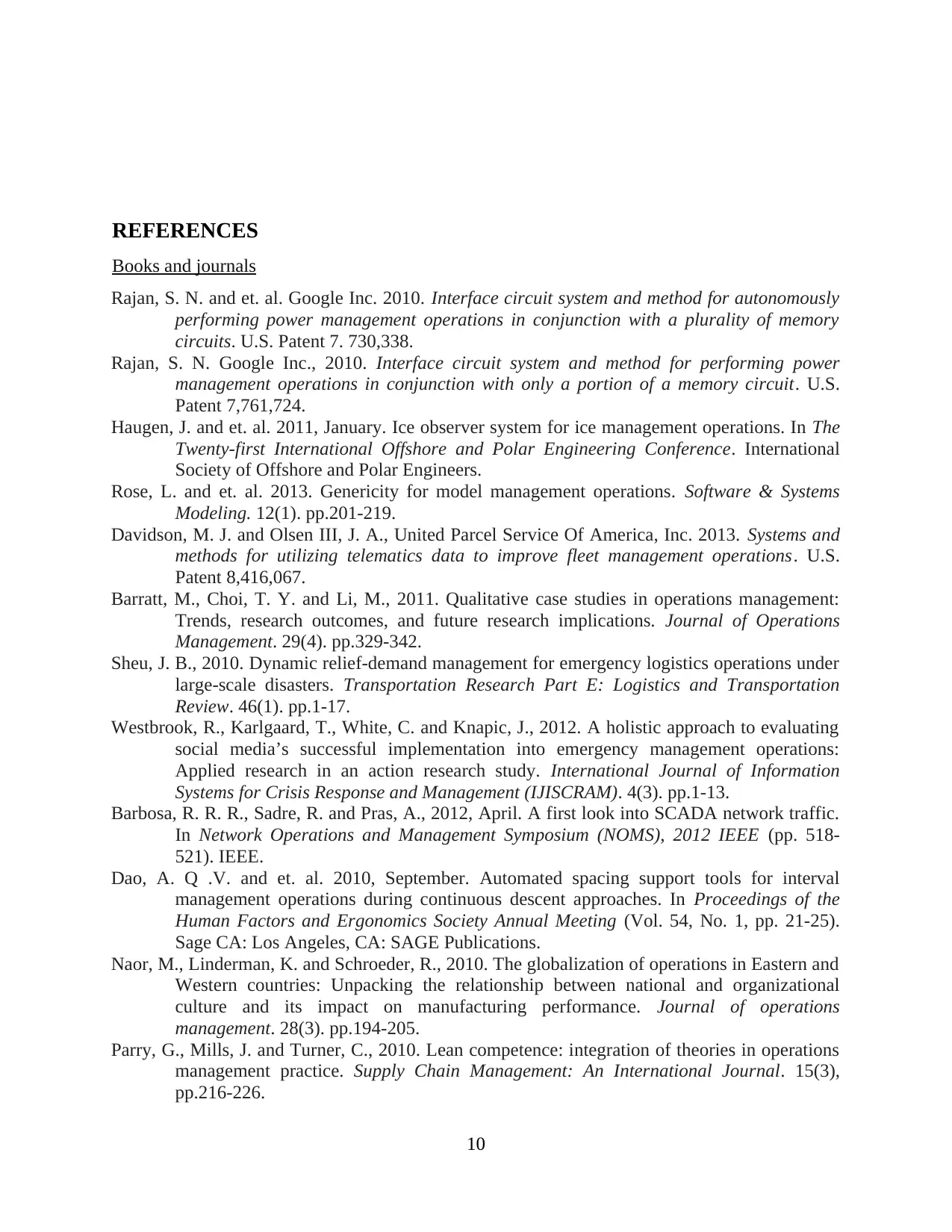
REFERENCES
Books and journals
Rajan, S. N. and et. al. Google Inc. 2010. Interface circuit system and method for autonomously
performing power management operations in conjunction with a plurality of memory
circuits. U.S. Patent 7. 730,338.
Rajan, S. N. Google Inc., 2010. Interface circuit system and method for performing power
management operations in conjunction with only a portion of a memory circuit. U.S.
Patent 7,761,724.
Haugen, J. and et. al. 2011, January. Ice observer system for ice management operations. In The
Twenty-first International Offshore and Polar Engineering Conference. International
Society of Offshore and Polar Engineers.
Rose, L. and et. al. 2013. Genericity for model management operations. Software & Systems
Modeling. 12(1). pp.201-219.
Davidson, M. J. and Olsen III, J. A., United Parcel Service Of America, Inc. 2013. Systems and
methods for utilizing telematics data to improve fleet management operations. U.S.
Patent 8,416,067.
Barratt, M., Choi, T. Y. and Li, M., 2011. Qualitative case studies in operations management:
Trends, research outcomes, and future research implications. Journal of Operations
Management. 29(4). pp.329-342.
Sheu, J. B., 2010. Dynamic relief-demand management for emergency logistics operations under
large-scale disasters. Transportation Research Part E: Logistics and Transportation
Review. 46(1). pp.1-17.
Westbrook, R., Karlgaard, T., White, C. and Knapic, J., 2012. A holistic approach to evaluating
social media’s successful implementation into emergency management operations:
Applied research in an action research study. International Journal of Information
Systems for Crisis Response and Management (IJISCRAM). 4(3). pp.1-13.
Barbosa, R. R. R., Sadre, R. and Pras, A., 2012, April. A first look into SCADA network traffic.
In Network Operations and Management Symposium (NOMS), 2012 IEEE (pp. 518-
521). IEEE.
Dao, A. Q .V. and et. al. 2010, September. Automated spacing support tools for interval
management operations during continuous descent approaches. In Proceedings of the
Human Factors and Ergonomics Society Annual Meeting (Vol. 54, No. 1, pp. 21-25).
Sage CA: Los Angeles, CA: SAGE Publications.
Naor, M., Linderman, K. and Schroeder, R., 2010. The globalization of operations in Eastern and
Western countries: Unpacking the relationship between national and organizational
culture and its impact on manufacturing performance. Journal of operations
management. 28(3). pp.194-205.
Parry, G., Mills, J. and Turner, C., 2010. Lean competence: integration of theories in operations
management practice. Supply Chain Management: An International Journal. 15(3),
pp.216-226.
10
Books and journals
Rajan, S. N. and et. al. Google Inc. 2010. Interface circuit system and method for autonomously
performing power management operations in conjunction with a plurality of memory
circuits. U.S. Patent 7. 730,338.
Rajan, S. N. Google Inc., 2010. Interface circuit system and method for performing power
management operations in conjunction with only a portion of a memory circuit. U.S.
Patent 7,761,724.
Haugen, J. and et. al. 2011, January. Ice observer system for ice management operations. In The
Twenty-first International Offshore and Polar Engineering Conference. International
Society of Offshore and Polar Engineers.
Rose, L. and et. al. 2013. Genericity for model management operations. Software & Systems
Modeling. 12(1). pp.201-219.
Davidson, M. J. and Olsen III, J. A., United Parcel Service Of America, Inc. 2013. Systems and
methods for utilizing telematics data to improve fleet management operations. U.S.
Patent 8,416,067.
Barratt, M., Choi, T. Y. and Li, M., 2011. Qualitative case studies in operations management:
Trends, research outcomes, and future research implications. Journal of Operations
Management. 29(4). pp.329-342.
Sheu, J. B., 2010. Dynamic relief-demand management for emergency logistics operations under
large-scale disasters. Transportation Research Part E: Logistics and Transportation
Review. 46(1). pp.1-17.
Westbrook, R., Karlgaard, T., White, C. and Knapic, J., 2012. A holistic approach to evaluating
social media’s successful implementation into emergency management operations:
Applied research in an action research study. International Journal of Information
Systems for Crisis Response and Management (IJISCRAM). 4(3). pp.1-13.
Barbosa, R. R. R., Sadre, R. and Pras, A., 2012, April. A first look into SCADA network traffic.
In Network Operations and Management Symposium (NOMS), 2012 IEEE (pp. 518-
521). IEEE.
Dao, A. Q .V. and et. al. 2010, September. Automated spacing support tools for interval
management operations during continuous descent approaches. In Proceedings of the
Human Factors and Ergonomics Society Annual Meeting (Vol. 54, No. 1, pp. 21-25).
Sage CA: Los Angeles, CA: SAGE Publications.
Naor, M., Linderman, K. and Schroeder, R., 2010. The globalization of operations in Eastern and
Western countries: Unpacking the relationship between national and organizational
culture and its impact on manufacturing performance. Journal of operations
management. 28(3). pp.194-205.
Parry, G., Mills, J. and Turner, C., 2010. Lean competence: integration of theories in operations
management practice. Supply Chain Management: An International Journal. 15(3),
pp.216-226.
10
⊘ This is a preview!⊘
Do you want full access?
Subscribe today to unlock all pages.

Trusted by 1+ million students worldwide
1 out of 13
Related Documents
Your All-in-One AI-Powered Toolkit for Academic Success.
+13062052269
info@desklib.com
Available 24*7 on WhatsApp / Email
![[object Object]](/_next/static/media/star-bottom.7253800d.svg)
Unlock your academic potential
Copyright © 2020–2025 A2Z Services. All Rights Reserved. Developed and managed by ZUCOL.





